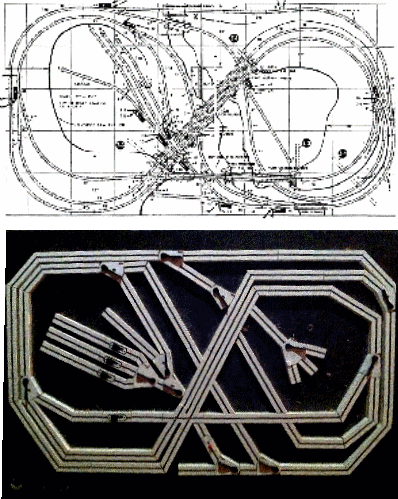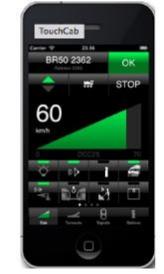 |
||||
My father in law John Yates began with the Granite Gorge & Northern trackplan, at right, which we modified slightly to give the station on the left 3 tracks plus a freight siding, also adding a locomotive depot with 3 tracks in the center of the right-hand loop. The track is Atlas code 100, though I've added two Fleischmann 3 way switches as well as a Fleischmann uncoupler track. Below the trackplan is the control panel, made with the Fleischmann schematic control system (it's the actual trackplan). This is a great system which allows one to set the switches and actually see the route a train will run on. The mountain was built using hard shell construction. I was apprehensive about building it but a friend advised me it would be easy, and he was right. First, I made a mound of balled up newspaper in the shape of the mountain. Next, I mixed Hydrocal white gypsum cement (I used the Woodland Scenics Hydrocal product) with water in a flat container. Then I put paper towels in the hydrocal mix and laid them over the balled up newspapers. The material started getting hard very quickly and was dry within about a half hour. Finally, I removed the newspapers. Voilà! The Poggenberg. I used a Heki grassmat on most of the landscape (especially the mountain) and the Noch static grass bottle applicator to apply additional static grass. The trees are Busch fir trees or handmade using pieces of wood and lichen. The layout originally used an analog block system: the old way of controlling trains was by regulating the voltage in the track with a transformer. This meant that all locomotives ran at the same speed. The way to get around this was to divide the track into "blocks" and then switch blocks to one or another transformer as the train progressed. This was very cumbersome and not very practical. A few years ago I converted to DCC (Digital Command Control), a system in which a microchip ("DCC decoder") was installed in each locomotive, effectively enabling one to vary the voltage inside the locomotive. DCC allows us to drive each locomotive individually and makes for much more realistic operation. The downside? It also dramatically increases the chance of train wrecks!
|
 |
|||
 At first we operated with a Lenz LZV 100 control unit and three handheld DCC throttles: a Lenz LH100, a Lenz LH90 and a Roco Lokmaus 2. However a few years ago I bought a Lenz ethernet interface and we now connect the LZV 100 to an Airport wireless base station and can run trains using the
At first we operated with a Lenz LZV 100 control unit and three handheld DCC throttles: a Lenz LH100, a Lenz LH90 and a Roco Lokmaus 2. However a few years ago I bought a Lenz ethernet interface and we now connect the LZV 100 to an Airport wireless base station and can run trains using the